CFW Solutions: A Blueprint for Selecting Your Killer Manufacturing App
Explore LNS Research's newest Solution Selection Matrix™ designed to guide end-users in creating their shortlist of CFW Application Vendors.
A monumental shift has occurred as industrial leaders realize competitors are moving forward with transformation initiatives and leaving them behind. In our LNS Research 2023 State of Industrial Transformation (IX) Tech survey of 321 manufacturing leaders, three mega themes emerge from the data:
Transformation Programs Are Up. We saw the most significant shift in eight years of tracking IX initiatives. In Figure 1 below, look at the change from 2021 to 2023 in companies responding “No” when asked if they have an IX program. It drops from 23% in 2021 to 12% in 2023 - a 92% shift! Fifty-four percent answered “Yes,” and 34% (up from 26% in our 2021 survey) are in the planning stages. It’s time to go. Already started? Go faster.
Executive Sponsorship is Key to Success. IX can’t be pursued as just another Industry 4.0 “project” but instead must be executed as a strategic, high-level business initiative that requires a senior business leader and clear executive sponsorship to be successful.
Operations Required! The Head of Global Operations must have a seat at the table as part of the cross-functional team leading the project. If the Operations leader is omitted, the risk of the initiative stalling dramatically increases.
IX is no longer seen as optional. For many, the business's survival demands that they move off their older, legacy manufacturing technology with limited, if any, interoperability that was not designed for the digital age. For business leaders, the data is clear that competitors are moving ahead with Industrial Transformation - innovating, modernizing, and deploying digital (emerging) technologies. If you’re in that 12% still saying no, you are falling behind, and the competitive landscape will become exponentially more challenging the longer you wait.
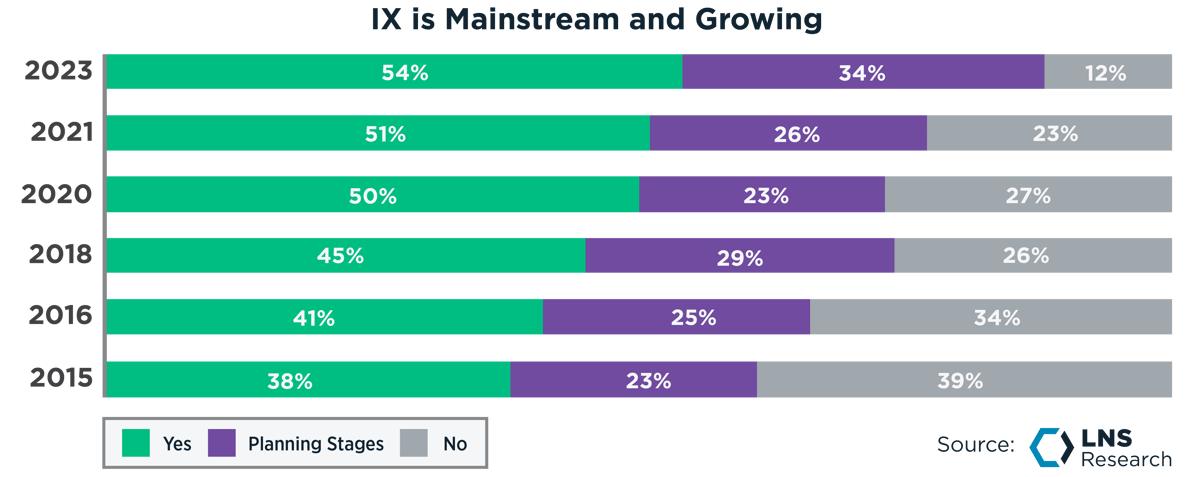
As industrial organizations successfully transform their technology, processes, and workforce at scale, significant business benefits have been documented:
98% of IX Leaders grew revenues by at least 3%, with an average of 10%
89% of IX Leaders reduced the Cost of Goods Sold (COGS) by at least 3%, with an average of 10%
86% of IX Leaders improved operating margins by at least 3%, with an average of 5%
Compared to our 2019 and 2021 State of IX Tech survey data, the effectiveness of IX programs is also improving, as indicated by the likelihood score in Figure 2. The likelihood of increasing revenue rose from 72% to 73%. The likelihood of reducing Cost of Goods Sold (COGS) increased from 57% to 77%, and the likelihood of increasing operating margin increased from 43% to 66%.
 Figure 2: IX Leaders’ Results from IX Programs
Figure 2: IX Leaders’ Results from IX ProgramsThese results do not come easy, and from what we see in the survey data and hear in follow-up interviews, there is a strong sense of urgency - rightly so because the business's survival depends on it. If you’re familiar with Daryl Conner’s books, “Managing at the Speed of Change” and "Leading at the Edge of Chaos," you know his organizational change "burning platforms" metaphor that represents a crisis or major problem that an organization must address immediately.
Much has been written hypothesizing that the COVID pandemic was the catalyst for accelerating the jump in companies starting transformation projects. While the pandemic certainly played a role in many industries, our survey asked specific questions on the top drivers for their initiatives (Figure 3).
Responding to supply chain disruption topped the list of drivers as manufacturing leaders seek to leverage modern digital systems with interconnectivity up and down supply channels to build in more agility, visibility, and traceability for their supply chains.
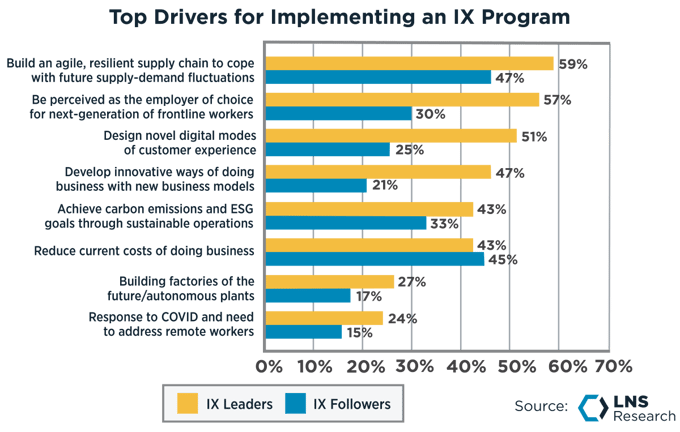 Figure 3: Top Drivers for IX Programs
Figure 3: Top Drivers for IX ProgramsThe second highest-ranking driver cited by our survey participants is being an “employer of choice.” This is all about attracting, hiring, training, and retaining workers. The next-generation workforce, often referred to as “digital natives,” are expecting modern digital technology (apps and systems) to execute their roles and tasks in the plant - a must to be perceived as an “employer of choice.”
LNS Research did an extensive global survey in late 2022 on the Future of Industrial Work (FOIW) and the Connected Frontline Workforce (CFW). In a blog unpacking that data, my research colleague Allison Kuhn notes that 72% of industrial organizations report that frontline workforce hiring and retention issues have negatively impacted operational performance.
When we change the question from “Top Drivers” to “What are the Top Challenges in implementing your IX program,” the workforce issue not only moves to the top but take note of the year-over-year increases in Figure 4 - a 41% rise from 2019 to 2021 and a 46% increase from 2022 to 2023.
In the Future of Industrial Work (FOIW) data, Allison found that 86% of manufacturers have implemented, are currently implementing, or plan to implement workforce initiatives as workforce issues continue to intensify. Just as the State of IX Tech survey data shows that manufacturers are recognizing, more than ever, that launching and/or accelerating an IX initiative is a business imperative, so too FOIW initiatives aren’t optional but mission-critical to attract, train, and retain next-gen employees.
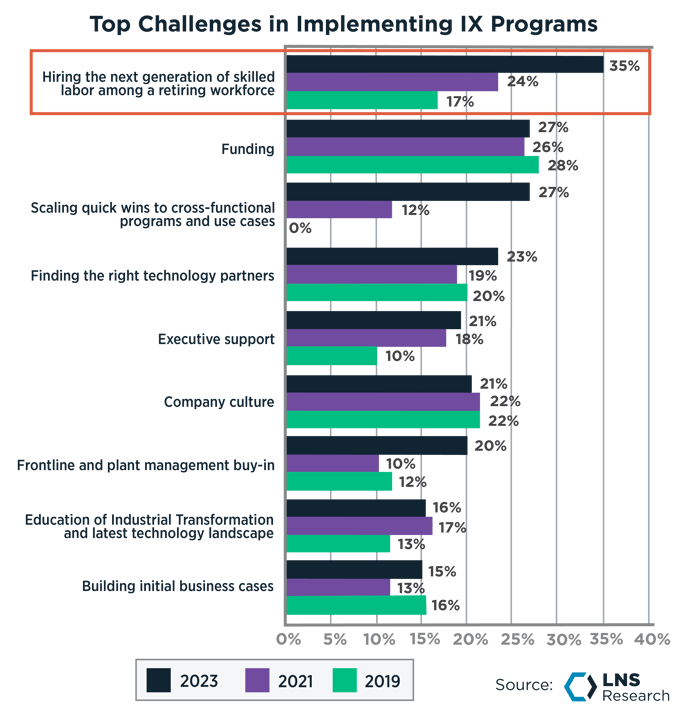 Figure 4: Top Challenges in Industrial Transformation (IX) Programs - YoY
Figure 4: Top Challenges in Industrial Transformation (IX) Programs - YoYWorkforce transformation as part of IX must account for more than a plan to attract, hire, train, and retain; it must also account for the knowledge and performance gaps inherent with the transition of 30-year employees retiring and being replaced by the next-generation workforce with 1-3 years of experience. The impact of this workforce transformation can require significant investments just to sustain the productivity levels of the past. It’s a concept known as Organizational Debt, and we have seen it manifest itself in higher safety incident rates and lower output. It can be overcome, but it takes time.
IX Leaders are implementing emerging technologies, on average, at more than twice the pace of Followers. Here are the top 12 emerging technology categories IX Leaders are implementing as part of their Industrial Transformation programs:
Advanced Industrial Analytics - 72%
Industrial Cyber Security - 60%
IX Platforms - 54%
Industrial Data Hub - 54%
Connected Frontline Workforce Solutions - 52%
Edge Solutions - 48%
AI/Machine Learning - 46%
Machine/Asset/Product Digital Twins - 46%
AR/VR - 44%
Plant Digital Twins - 42%
Autonomous Drones/Robots/Cobots/Crawlers - 40%
Vision Systems - 38%
There were no big surprises in the data on emerging technology IX Leaders invest in. Advanced Industrial Analytics (AIA) solutions in the age of AI are powering more accurate predictions and overall improved decision-making from the shop floor to the top floor.
One category that I did not expect to see in the top three was cyber security. This required some additional investigation. After speaking with some experts in the cyber security world in the USA, UK, Germany, and Israel, the current focus is on industrial plants and manufacturers protecting OT and IoT data, a somewhat different discipline than traditional IT cyber security of corporate networks. Most of us in the industrial world remember a few incidents that also put this ranking in context:
Malware attacks on industrial control systems (ICS): Stuxnet, a malware attack discovered in 2010, targeted ICS used in nuclear power plants.
Botnet attacks on IoT devices: In 2016, a botnet attack was launched using compromised IoT devices and caused a significant outage of the DynDNS DNS service. The outage disrupted data centers and greatly limited (in some cases prevented) access to many corporate data lakes and popular websites.
Ransomware attacks on critical infrastructure: In 2021, a ransomware attack on the Colonial Pipeline caused the shutdown of the pipeline, which supplies nearly half of the East Coast of the United States with gasoline and diesel fuel.
I have previously written about the rush of many solution providers to get their apps available in the Hyperscaler marketplaces, specifically AWS and Microsoft Azure. At the AWS re:Invent conference in 2022, Tony Hemmelgarn, CEO of Siemens Digital Industries Software, presented on Siemens Xcelerator software for industry and worked with AWS on application development tailored to the cloud. Hemmelgarn concluded his remarks by emphasizing that “most of our applications now are available on the AWS Marketplace for our customers to be able to purchase easily.”
To get more data on this trend, we included some questions in the 2023 State of IX Tech survey asking how companies purchase or subscribe to software offerings. Sixty-five percent of IX Leaders and 58% of Followers answered that they buy software directly from the solution provider. However, 52% of IX Leaders and 38% of Followers told us they also purchased software through the Hyperscaler marketplaces and/or system integrators (Figure 5). This trend is a win-win for both solution providers (lower cost of sales and powerful ecosystem reach) and owner-operator buyers, allowing them to purchase and deploy quickly by transacting directly in their AWS or Azure instance. In follow-up interviews, buyers report this approach overcomes several hurdles in IX program software evaluation and budget management, ultimately speeding up deployment, scale, and adoption.
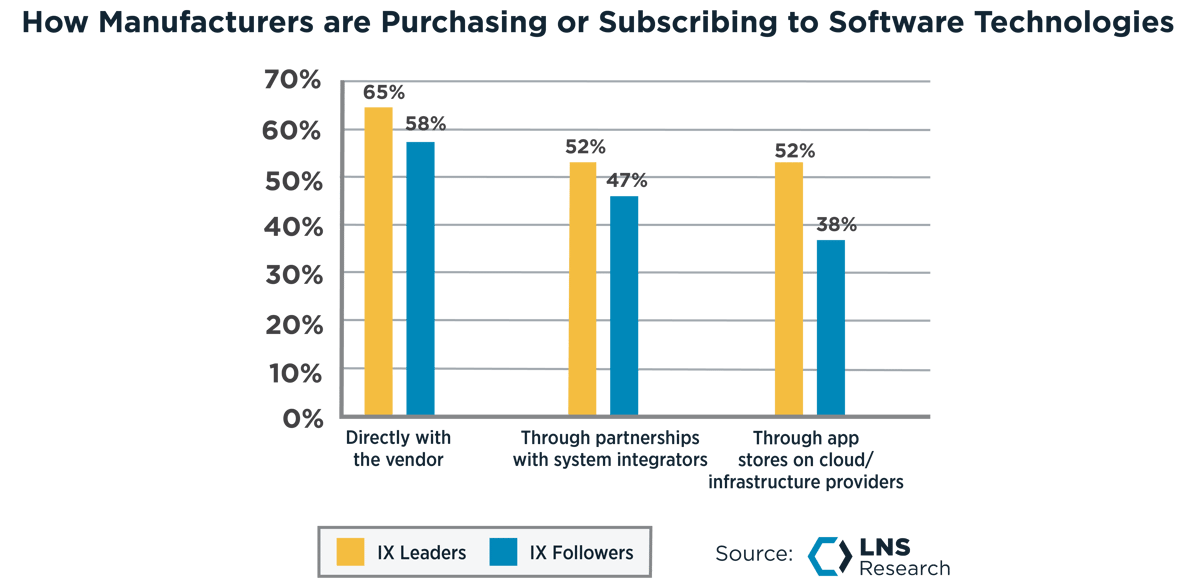 Figure 5: Purchasing Trends for Emerging Technologies
Figure 5: Purchasing Trends for Emerging TechnologiesIn the LNS Research Transformation Maturity Model (Figure 6), we outline the Vision-Focused stages culminating in a pilot or lighthouse plant to prove out the IX program. Avoiding the Transformation Chasm requires what we call the Pivot to Value. This enables scale, and the transformed way of doing business becomes embedded in the company culture in the Value-Focused stages.
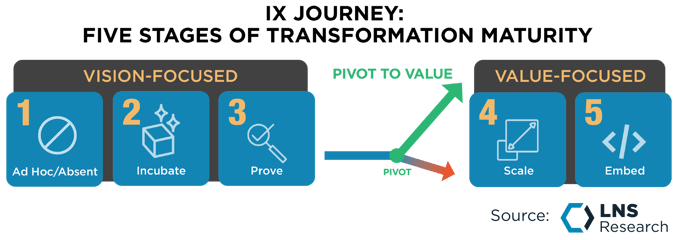 Figure 6: LNS Research Transformation Maturity Model
Figure 6: LNS Research Transformation Maturity ModelThe best practice is for the corporate team to fund the pilots and education in the Vision stages to prove out the approach and gain buy-in from the business units and/or plants. However, in the Value stages, the funding approach should shift to the P&L leaders at the business level to invest to get their own ROI. If the Executive team wants those P&L Leaders to own the result, they must own the spending on the infrastructure, applications, and implementation.
Get moving on your IX initiative because your competitors are leaving you behind. The data couldn’t be clearer on the global shift that’s taken place. If your program is already underway, look for ways to accelerate, being careful not to fall into the Transformation Chasm.
One of the primary traits of a successful transformation initiative is a top-down push from the leadership team and a bottom-up pull from the plant level. Without that dynamic, about 70% of transformation programs initially fail. Our LNS Research IX Framework recommends the best structure for that leadership team being cross-functional with the key stakeholders represented (IT, OT, Operations, Maintenance, etc.). Far too often, we see the Heads of Operations not being included, which changes the dynamic to IX as something happening TO or FOR the Head of Operations when success requires IX to be done WITH the Head of Operations, so the program is being built into the core of ops strategy. The Heads of Operations also bring a broader, strategic view that goes beyond technology and provides the IX project team with a perspective on transforming people and processes in concert with technology.
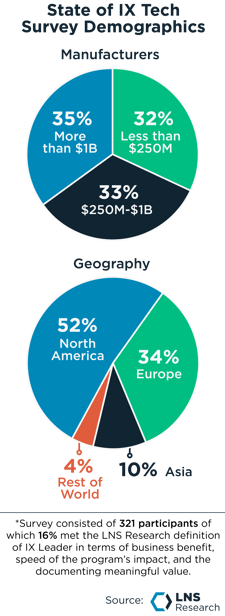 Our research has also identified that many companies struggle to scale early wins into widespread success. Copy and paste never works, as no two plants are exactly the same. We have documented many examples where technology-led projects have generated initial momentum and may get some quick wins, but they need to pivot to business-led initiatives to scale across the enterprise successfully.
Our research has also identified that many companies struggle to scale early wins into widespread success. Copy and paste never works, as no two plants are exactly the same. We have documented many examples where technology-led projects have generated initial momentum and may get some quick wins, but they need to pivot to business-led initiatives to scale across the enterprise successfully.
Deliver the win-win. A successful IX program that delivers modern, digital, smart, connected technology will not only transform your operations but will greatly improve your chances of winning the battle for top talent as well as reduce turnover. Digital natives demand modern technology. They have easy access to AI everywhere else in life and expect to be equipped with the same at work.
Do the math. It’s true that funding IX initiatives remains a top challenge (see Figure 4 above). Manufacturers ranked funding as one of their top challenges in implementing IX in 2019, 2021, and 2023 surveys. However, the business impact once the program is scaled up and adopted by the organization is well documented. Revenue went up a minimum of 3% and on average 10%, COGS went down a minimum of 3% and on average 10%, and Operating Margin went up a minimum of 3% and on average 5%. IX Leaders are delivering and documenting significant returns on investment.
LNS Research membership includes access to the complete data set and in-depth analysis of the 2023 State of IX Tech survey. Contact the LNS Research Commercial team for Membership options, and stay tuned for more research insights coming soon.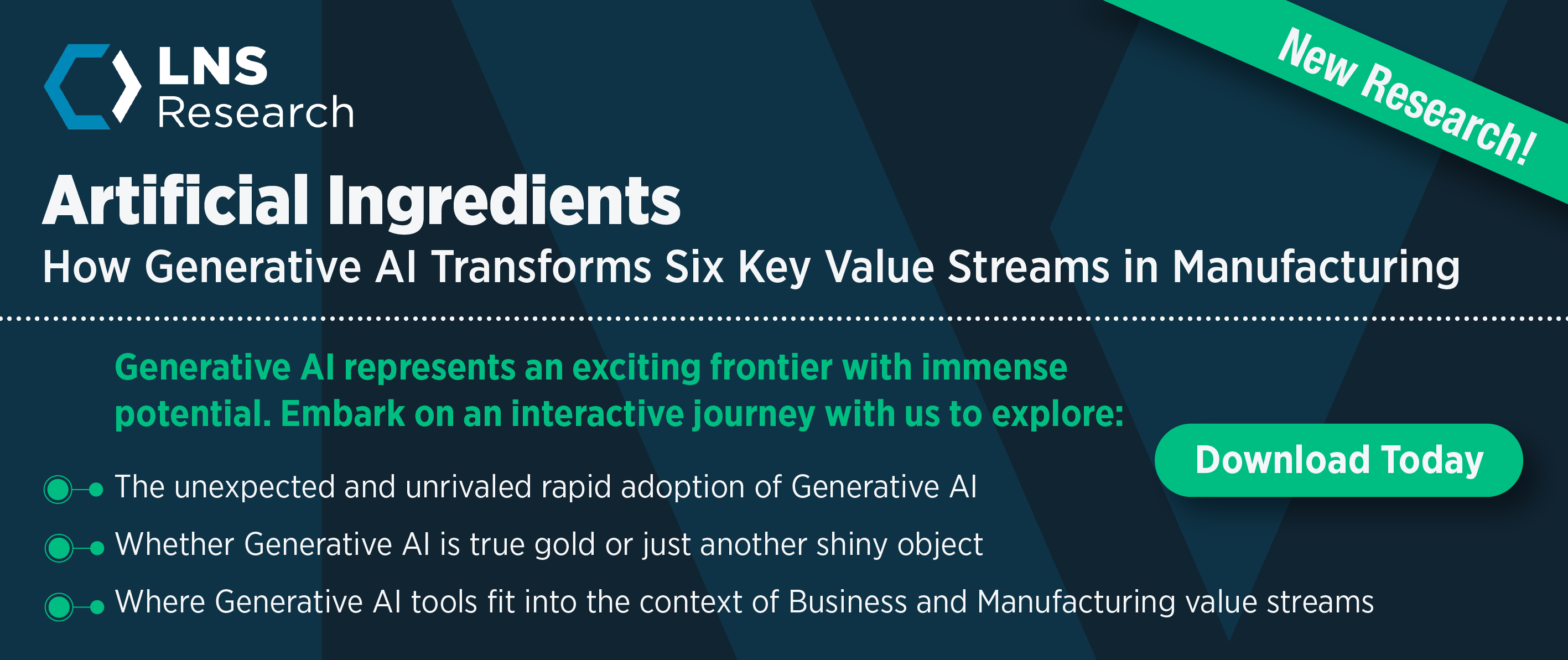
As a member-level partner of LNS Research, you will receive our expert and proven Advisory Services. These exclusive benefits give your team:
Let us help you with key decisions based on our solid research methodology and vast industrial experience.
BOOK A STRATEGY CALLSiemens Acquires Camstar: Better Realizing Innovation for 3 Vertical Industries
Five Ways Industrial AI is Shaking Up Manufacturing (and Who’s Doing It)
The Definitive Guide to Manufacturing Acronyms
What Is Industrial DataOps & Why Does Every Manufacturer Need It?
Software-Defined Automation: Surprise... It's Not About Cost Savings
Explore LNS Research's newest Solution Selection Matrix™ designed to guide end-users in creating their shortlist of CFW Application Vendors.
Connected Frontline Workforce (CFW) technology is a proven enabler in today’s operations environment. Learn how to accelerate your CFW Value Curve...
Successful manufacturers focus on efficiency and productivity; learn how to separate the must-haves from the nice-to-haves to improve profitability.
The Industrial Transformation and Operational Excellence Blog is an informal environment for our analysts to share thoughts and insights on a range of technology and business topics.